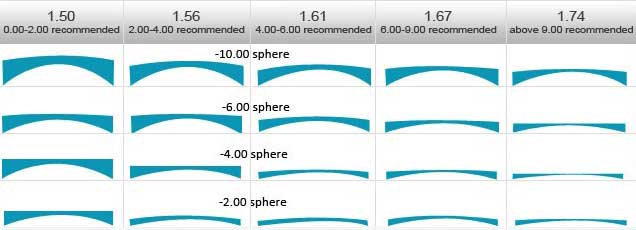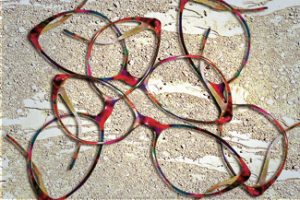In recent years, the transition from glass to plastic lenses has revolutionized the way we see.
In the past, eyeglass lenses were made of glass. However, in recent years, lenses have transitioned to a durable plastic, that is lighter in weight, and less prone to breaking— providing a more comfortable experience.
What is the difference between a lens for farsightedness and a lens for nearsightedness?
If you are farsighted, your lenses will be thicker in the center and thinner on the periphery. A farsighted prescription is written with a “plus” sign, such as +2.00 diopters (D).
If you are nearsighted, your lenses will be thinner at the center and thicker on the periphery. A nearsighted prescription is written with a “minus” sign, such as -2.00 diopters (D).
Different types of lenses
Single vision lenses are the most basic, and least expensive type of lenses. These lenses are designed for correcting vision for either near or distant clarity.
Bifocal lenses contain two optical powers to accommodate clear vision for both near and far. The lens is divided into two segments, the top of the lens contains the distance vision prescription, while the bottom of the lens contains the near vision prescription. Some bifocals contain a bisecting horizontal line between the two lens powers.
Trifocal lenses contain three optical powers— distance, intermediate and near vision, with two segmenting lines to delineate the powers. The intermediate segment is located above the segment for near vision and is helpful for viewing objects at arm’s length, such as a computer, or car dashboard.
Progressive lenses, also called multifocal lenses are similar to bifocals and trifocals, but contain multiple lens powers to provide vision at all distances— close up, intermediate, distance, and any other lens power necessary for vision clarity. Multifocals gradually blend the lens powers together without a bisecting line, making them more attractive than bifocals. The downside of multifocals is that the clear zone for each part of the lens may be limited.
Polycarbonate and trivex lenses are impact-resistant, thin, and lightweight. These lenses are ideal for playing sports, as they are less prone to damage. They are also designed with built-in UV protection.
High-index plastic lenses are thinner, lighter, and more comfortable than regular lenses. These lenses are ideal for those with higher prescriptions, specifically those with strong farsightedness.
Aspheric lenses contain various degrees of curvature from the center of the lens to its periphery. A flatter curve allows for thinner and flatter lenses, and reduces eye magnification for farsighted prescriptions. Aspheric lenses may also improve the clarity of your peripheral vision.
Computer lenses filter out blue light— reducing eye strain, fatigue, and headaches— and protecting your overall ocular health. Computer glasses may be purchased without a prescription. If you already wear prescription glasses, your lenses can be treated with a blue light-blocking coating.
Photochromic lenses also known as transition lenses, are clear indoors and darken when exposed to sunlight. These lenses eliminate the need for sunglasses and are more convenient for those who wear glasses full time to protect their eyes from UV radiation. Photochromic lenses are technically a treatment that can be added to your prescription lenses of any type.
Polarized sunglasses reduce glare from surfaces such as water and snow. They are an ideal choice for driving and playing sports.
Schedule an eye exam with an eye doctor to find out which lenses you need for clear and comfortable vision.
SEE RELATED: Optical Lenses for Children
Why are high index lenses so popular?
High-index lenses are recommended if you have a high optical prescription for nearsightedness, farsightedness, or astigmatism. Lenses that contain a higher prescription, are generally quite thick and heavy. This is because the lens needs to be a certain thickness to accurately bend light to correct the refractive error.
While both regular and high index lenses function in the same way, high index lenses are designed to bend light in the most effective way for more natural vision, and to eliminate the need for thick lenses.
High index lenses are thinner and lighter than regular lenses. These lenses are recommended for all types of refractive errors, but are ideal for those with strong farsightedness prescriptions— a thicker lens for this type of prescription generally produces a stronger magnification of the eyes. With the aspheric design of high index lenses, the center of the lens can be made thinner and create a flatter curvature— reducing the magnification of the eyes.
The following types of lenses are available in high-index materials:
- Aspheric
- Progressive
- Polycarbonate
- Photochromic
- Polarized
High index lenses are generally scratch resistant and can fit into almost any frame. They can also be treated with special coatings to facilitate improved vision. Many people opt for the following coatings:
- Anti-scratch coatings increase lens durability.
- Anti-reflective coatings prevent light from reflecting off the lenses, glare, and halos around lights.
- UV-protection coatings protect your eyes from the sun’s harmful rays.
Why are high index lenses thinner than regular plastic lenses?
High-index lenses are thinner than regular plastic lenses because they have a higher refractive index than plastic. Plastic lenses contain a refractive index of 1.50, while high-index lenses can range from 1.53 to 1.74.
The higher the index, the thinner the lens— a lens with an index of 1.74 could be up to 50 percent thinner than a regular lens with an index of 1.5, with the same prescription.
The image below compares different types of hi-index lenses:

Which type of lens is right for me?
When ordering new glasses, be sure to bring a recent optical prescription from your eye doctor. Your prescription will help to determine the most appropriate choice of lenses for your specific needs.
That being said, it is always a good idea to do some research before purchasing a new pair of glasses to better understand the type of glasses you will be wearing and ensure optimal satisfaction.
LEARN MORE: Optical and Contact Lenses
If you are still unsure about which type of lenses you are looking for, speak with your eye doctor. Your doctor is available to answer any questions you may have about purchasing new lenses.









